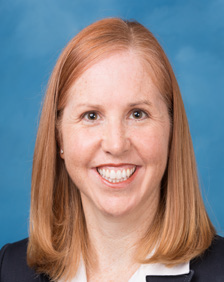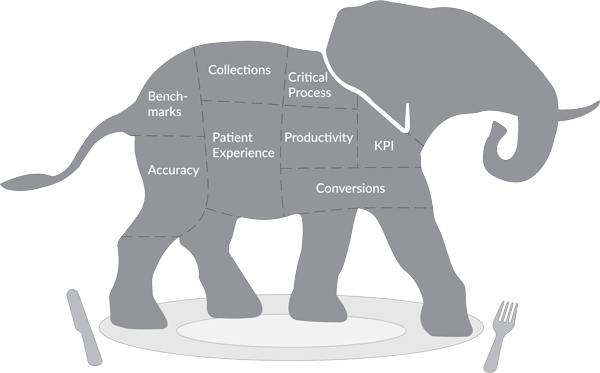Taking the AccessKeys One Bite at a Time
A roadmap to implement key performance indicators for the front-end revenue cycle
By Dr. Michelle Fox and Paul Shorrosh
We have all heard the saying, “What gets measured, gets done.” This is certainly true in Healthcare Revenue Cycle Management (RCM), where standard performance measures for the back end are common (e.g., net days in accounts receivable, days cash on hand, clean claim rate and first-pass denial rate).
These key performance indicators (KPIs) help hospitals measure the performance of vital back-end functions such as claims processing and denials management. Standard metrics also allow for meaningful peer comparisons.
Although HFMA and other research organizations have settled on standard KPIs for back-end processes, front-end KPIs were missing until 2012, when NAHAM’s Industry Standards Committee (ISC) developed the AccessKeys®, which is now in its third version. Most hospital leaders understand instinctively that Patient Access has a significant impact on patient experience and the revenue cycle, but the AccessKeys prove it with reliable data.
The Importance of Front-End KPIs
From ordering, scheduling, preregistration, patient arrival and registration processes, Patient Access is the only department in the health system that has personal interaction with every patient seeking care, on both a human and a financial level. These teams of hard-working professionals have an incredible privilege — and responsibility — to create positive patient experiences and secure revenue, but only if they are operating at peak performance. And if they are operating at peak performance, you want everyone to know about it.
But how will Patient Access leaders know what success looks like without standard measures that apply to all situations in all health systems? Given multiple complex processes, how can one Patient Access team measure performance and compare to peers meaningfully despite vast differences in facility size, demographics, geography, patient services, payer mix, staff pay, availability, turnover and EMR as well as other technologies?
NAHAM’s answer to this dilemma has been in the works since 2012 when the first version of the AccessKeys was released. As a labor of love from a dedicated group of volunteer Patient Access leaders, these 34 KPIs bring science to the art of Patient Access. If you are an access professional with the desire and passion to break through the crisis management of daily operations to provide focused strategic leadership, this resource can be the game-changer you’ve been looking for.
The 34 AccessKeys are grouped into six domains:
- ——Point of Service Collections: 6 keys
- Conversions: 2 keys
- Patient Experience: 8 keys
- Critical Processes: 9 keys
- Productivity: 6 keys
- Accuracy: 2 keys
Each KPI includes peer benchmark goals based on Patient Access manager surveys. This gives leaders three levels of performance to shoot for: good, better and best.
Case Study 1: Novant Health
Novant Health is a 14-hospital health system on the East Coast. Using the productivity domain KPIs, Novant was able to increase their average registrations per person per day to 40, decrease their cost per registration from $5.46 to $2.70 and optimize their staffing model and hours of operation. NAHAM’s Registration Time and FTE Calculator is available to all members, which helps
calculate cost per registration. To find the calculator, go to: www.naham.org > Resources > FTE Calculator.
Case Study 2: Health First
Health First is a four-hospital health system in central Florida. Using POS collections KPIs and benchmarks, Health First increased their number of estimates to registrations, their estimation accuracy rate and ultimately their POS Collections as a percent of net revenue from 1.6 percent to 2.2 percent.
 Ideas are Easy. Implementation is Hard.
Ideas are Easy. Implementation is Hard.
Now that we have the AccessKeys, how do we go about implementing them? With 34 KPIs, it may seem like an overwhelming task. But here’s the great news: You don’t have to implement all of them. You can focus on a core group of keys that are most relevant to your organization, and expand from there.
When looking at a large task, Creighton William Abrams, Jr., a U.S. Army General who commanded the military in the Vietnam War, says “The way to eat an elephant is one bite at a time.” In other words, when you are faced with a difficult task, you simply take it slow, one part at a time. That is how we recommend implementing the AccessKeys — one bite at a time. You do not need to swallow all 34 keys at once. To prevent biting off more than you can chew, we suggest starting small; maybe choose one key or domain at a time to focus on. For example, if your organization needs to increase POS collections, you can focus on those KPIs. If your greatest need is denials reduction and prevention, you can focus on the critical process KPIs.
Getting Started
All healthcare organizations are different — some may already be using several of the keys, and some may not be using any of them. The first place to start when implementing is to perform a self-assessment by looking at the 34 AccessKeys and determining which ones your organization is currently measuring. If your organization has already adopted some of the AccessKeys, then we encourage you to look at others and tackle the ones that can benefit your organization.
If you are not measuring any, the next step is to identify what is important to your organization and your operations, as well as what you want to measure. Start simple; maybe select a couple of keys or a domain to focus on for the first year and then add additional domains or keys the next year and so on. It all depends on your comfort level as well as what it is you want to focus on to improve performance. You have the freedom to choose what best fits your organization. What works for one hospital may not work for another. If you are struggling with which AccessKeys® to implement or are not sure which ones are most important to your organization, we encourage you to speak to your CFO to get their thoughts and buy-in.
Click here to read the 2018 NAHAM AccessKeys Journal.
Not sure where to start or how to use AccessKey benchmarks to improve your facility’s efficiency and bottom line? Click here for our webinar on-demand – How To Use NAHAM’s AccessKeys and Best Practices to Increase POS Collections.
Helpful Resources
Once you have determined which AccessKeys to incorporate into your daily and monthly calculations, you will need to determine where the source data will come from and what systems need to be accessed, such as your ADT/HIS or other reporting systems. You may also need to reach out to other departments such as patient financial services, information technology or accounting for support.
There are numerous resources available to help you along the journey of implementing the AccessKeys. The AccessKeys Users Guide is an invaluable resource, offered by NAHAM free of charge to members. NAHAM also offers recorded webinars, a “Getting Started” guide and BridgeFront AccessKeys educational courses. The NAHAM Industry Standards Committee (ISC) can also be used as a resource. As the committee that created the AccessKeys, all members are well-versed in the AccessKeys and have adopted many of them at their respective organizations. The ISC members are committed to ensuring that all NAHAM members are aware of the AccessKeys® and are provided with the necessary assistance needed for implementation. Please contact NAHAM for committee member names and contact information.
AccessKeys Awards Program
Knowing that it is not easy to implement something new, especially standard performance metrics, NAHAM wanted to recognize those who have successfully adopted some AccessKeys within their organization. This May at NAHAM’s 44th Annual Conference in Denver, we will be debuting the AccessKeys Awards Program. Three high-performing winners will be given the “Best of Keys” award. If you are interested in submitting an application for your organization, it is not too late. Applications will be accepted online until March 1. The winners will be announced at the beginning of April and will be awarded a complimentary conference registration and one-night hotel stay. This year’s criteria focuses on POS collections. Don’t delay, apply today! Take this opportunity to show off the great work you and your staff are doing at your organization. Share your successes with your leadership and all other Patient Access professionals. For any questions regarding the AccessKeys Awards Program, please contact Michelle Fox, Industry Standards Committee Chair, at michelle.fox@health-first.org or 321-434-6017.
Start using the NAHAM AccessKeys today and be the one to take your organization from “Good to Better to BEST.”
Hope you’re hungry!
 Michelle Fox is the director of revenue operations/Patient Access at Health First in Brevard County, Florida. Michelle is nationally certified in healthcare access management. She holds a bachelor of health science education, a master of health administration and a doctorate of business administration. Michelle currently serves as Chair for the NAHAM Industry Standards Committee and is a NAHAM board member. Michelle Fox is the director of revenue operations/Patient Access at Health First in Brevard County, Florida. Michelle is nationally certified in healthcare access management. She holds a bachelor of health science education, a master of health administration and a doctorate of business administration. Michelle currently serves as Chair for the NAHAM Industry Standards Committee and is a NAHAM board member. |
 Paul Shorrosh is the founder/CEO of AccuReg. His company is transforming the revenue cycle from the front end by empowering Patient Access teams with the right people, processes and systems. Paul is nationally certified in healthcare access management and is credited as the architect of the NAHAM AccessKeys, which he developed while serving as the NAHAM Industry Standards Committee Chair from 2014–2017 and as a NAHAM board member from 2008–2017. Paul Shorrosh is the founder/CEO of AccuReg. His company is transforming the revenue cycle from the front end by empowering Patient Access teams with the right people, processes and systems. Paul is nationally certified in healthcare access management and is credited as the architect of the NAHAM AccessKeys, which he developed while serving as the NAHAM Industry Standards Committee Chair from 2014–2017 and as a NAHAM board member from 2008–2017. |
References:
1. NAHAM AccessKeys® – https://www.naham.org
2. “When eating an elephant take one bite at a time.” – https://simple.wikiquote.org/wiki/Creighton_Abrams
3. Bridgefront – https://www.bridgefront.com/
 Ideas are Easy. Implementation is Hard.
Ideas are Easy. Implementation is Hard.